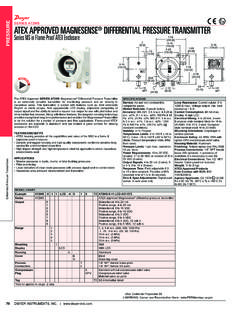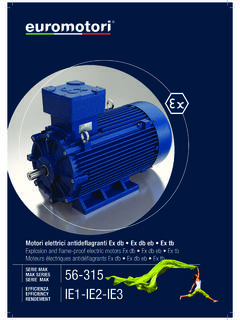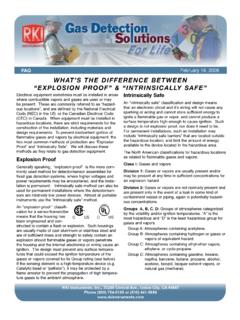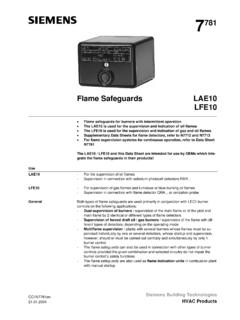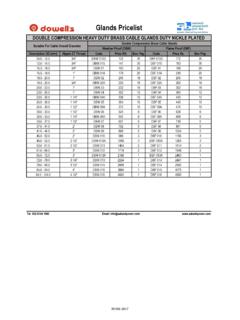Transcription of Document Page Engineering Technical Bulletin 1/2 …
1 Engineering Technical Bulletin Document AITA-11-0007 Page 1/2 forklifts modified TO operate IN hazardous AREAS Rev. Date 09-Aug-2011 Rev A Hazards such as explosive gas or vapour and combustible dusts may exist where forklifts operate . The end user of the forklift is responsible for having such hazardous areas classified in accordance with Classification of hazardous areas . hazardous areas are classified in two distinct groups. Flammable gases, vapours and liquids make up one group, which traditionally had been known as Class I. Dusts, fibres and flyings make up the second group previously known as Class II. hazardous areas are classified by zones according to the length of time the hazard is present or likely to be present. The table 1 shows the current zones as specified in the Australian Standards AS/NZS , AS/NZS and AS/NZS Note: If there is a change to the classification of the area where the flameproof forklift operates or the characteristics or the combustible materials change then a review must be conducted to ensure continued compliance with the revised area classification with reference to Due to the high risks associated with flameproof forklifts working in hazardous areas education and training of staff and full compliance to AS2359 Powered industrial trucks is essential.
2 Operators need additional training and pre operating checks need to be in line with manufactures recommendations provided with the flame proof truck forklifts operating in these hazardous areas should be modified to comply with Powered industrial trucks hazardous areas (ref Dangerous Goods Code of Practice -NSW) to control the risks associated with the hazardous areas, the modified forklifts are commonly referred to as flameproof forklifts . Where in doubt seek guidance from your local regulatory authority. Forklift manufacturers and suppliers should offer only flameproof forklifts which are suitable for use in the particular hazardous area and that comply with the relevant requirements of for IC forklifts , AS1915 for battery electric forklifts . Operating surface floor needs to be a conductive surface ref.. The owner and end user are responsible for correct use and proper maintenance of flameproof forklifts .
3 All maintenance should be carried out by trained and qualified technicians that are conversant with the equipment and flameproof modifications. The unauthorised replacement of and or modification of any of these special components and or changes to flame proof truck could lead to: - The flame proof truck becoming unsafe for use in the designated hazardous areas. - The statutory approval for this flame proof truck becoming invalidated. Engineering Technical Bulletin Document AITA-11-0007 Page 2/2 forklifts modified TO operate IN hazardous AREAS Rev. Date 09-Aug-2011 Rev A Maintenance & Replacement Parts Maintenance must include the specific items and tests specified in appendix A, and specific details of the maintenance must be documented and kept. Replacement parts must be fit for purpose, interchangeable with the part being replaced, quality of of parts shall not be less than that of the original equipment for all components from the obvious flameproof items such as flame traps and intrinsically safe relays to the less obvious items.
4 Items such as fan belts and tyres, all transmission belts must be fire resistant and antistatic, and tyres must be constructed of conductive or antistatic material. Note: 1. Enclosure screws must be in place and any replacement screws/bolts must be in accordance with flame proof enclosure manufacturers recommendations. 2. Non marking tyres are not recommended, as they are not conductive due to the lack of carbon black. 3. If non marking tyres are used, a static strap or a bonding earth strap must be fitted to the forklift. TABLE 1 NOTE: Mobile materials handling equipment is not permitted in Zone 0 or Zone 20 Zones applicable for flammable gases, vapors and liquids (previously known a Class I) ZONE 0 Flammable atmosphere continuously present or present for long periods (more than 1000 hours/year). ZONE 1 Flammable atmosphere is likely to occur in normal operations (more than 10 hours/year but less than 1000 hours/year).
5 ZONE 2 Flammable atmosphere is unlikely to occur in normal operations (less than 10 hours/year). Zones applicable for dusts, fibers and flyings (previously known a Class II) ZONE 20 Area in which combustible dust as a cloud is continuously or frequently present. ZONE 21 Area not classified Zone 20 in which combustible dust as a cloud is likely to occur during normal operation. ZONE 22 Area not classified Zone 21 in which combustible dust clouds may occur infrequently and persist for only a short period.


